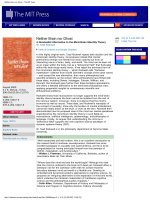the mit press design concepts in programming languages aug 2008
Bạn đang xem bản rút gọn của tài liệu. Xem và tải ngay bản đầy đủ của tài liệu tại đây (20.68 MB, 1,347 trang )
Design Concepts
in Programming
Languages
FRANKLYN TURBAK AND
DAVID GIFFORD
WITH MARK A. SHELDON
Design Concepts
in Programming Languages
TURBAK,GIFFORD,
AND SHELDON
COMPUTER SCIENCE/PROGRAMMING LANGUAGES
Hundreds of programming languages are in use today—scripting languages
for Internet commerce, user interface programming tools, spreadsheet mac-
ros, page format specification languages, and many others. Designing a
programming language is a metaprogramming activity that bears certain
similarities to programming in a regular language, with clarity and simplicity
even more important than in ordinary programming. This comprehensive text
uses a simple and concise framework to teach key ideas in programming lan-
guage design and implementation. The book’s unique approach is based on
a family of syntactically simple pedagogical languages that allow students to
explore programming language concepts systematically. It takes as its prem-
ise and starting point the idea that when language behaviors become incred-
ibly complex, the description of the behaviors must be incredibly simple.
The book presents a set of tools (a mathematical metalanguage, abstract
syntax, operational and denotational semantics) and uses it to explore a
comprehensive set of programming language design dimensions, including
dynamic semantics (naming, state, control, data), static semantics (types,
type reconstruction, polymorphism, effects), and pragmatics (compilation,
garbage collection). The many examples and exercises offer students oppor-
tunities to apply the foundational ideas explained in the text. Specialized
topics and code that implements many of the algorithms and compilation
methods in the book can be found on the book’s Web site, along with such
additional material as a section on concurrency and proofs of the theorems
in the text. The book is suitable as a text for an introductory graduate or ad-
vanced undergraduate programming languages course; it can also serve as
a reference for researchers and practitioners.
Design Concepts
in Programming Languages
FRANKLYN TURBAK AND
DAVID GIFFORD
WITH MARK A. SHELDON
Franklyn Turbak is Associate Professor in the Computer
Science Department at Wellesley College. David Gifford
is Professor of Computer Science and Engineering at MIT.
Mark A. Sheldon is Visiting Assistant Professor in the
Computer Science Department at Wellesley College.
“There is a paucity of good graduate-level textbooks on the
foundations of programming languages, no more than four
or five in the last two decades. Nothing to compare with
the profusion of excellent texts in the other core areas of
computer science, such as algorithms or operating systems.
This new textbook by Franklyn Turbak, David Gifford, and
Mark Sheldon—comprehensive, thorough, pedagogically
innovative, impeccably written and organized—greatly
enriches the area of programming languages and will be
an important reference for years to come.”
Assaf Kfoury
Department of Computer Science, Boston University
“This book is an excellent, systematic exploration of ideas
and techniques in programming language theory. The book
carefully, but without wasting time on extraneous compli-
cations, explains operational and denotational semantic
techniques and their application to many aspects of
programming language design. It will be of great value for
graduate courses and for independent study.”
Gary T. Leavens
School of Electrical Engineering and Computer Science,
University of Central Florida
THE MIT PRESS MASSACHUSETTS INSTITUTE OF TECHNOLOGY CAMBRIDGE, MASSACHUSETTS 02142 HTTP://MITPRESS.MIT.EDU
COVER PHOTOGRAPH: DAVID GIFFORD
978-0-262-20175-9
On the cover is an inuksuk, a signpost used by the Inuit in the Arctic to provide guidance
in vast wilderness. The concise semantics, type rules, effect rules, and compilation
transforms in this book have been valuable inuksuit to the authors in the programming
language landscape.
MD DALIM #970524 6/24/08 CYAN MAG YELO BLK
Design Concepts in Programming Languages
Design Concepts in Programming Languages
Franklyn Turbak and David Gifford
with Mark A. Sheldon
The MIT Press
Cambridge, Massachusetts
London, England
c
2008 Massachusetts Institute of Technology
All rights reserved. No part of this book may be reproduced in any form by any
electronic or mechanical means (including photocopying, recording, or information
storage and retrieval) without permission in writing from the publisher.
MIT Press books may be purchased at special quantity discounts for business or sales
promotional use. For information, please email special
or write
to Special Sales Department, The MIT Press, 55 Hayward Street, Cambridge, MA
02142.
This book was set in L
A
T
E
X by the authors, and was printed and bound in the United
States of America.
Library of Congress Cataloging-in-Publication Data
Turbak, Franklyn A.
Design concepts in programming languages / Franklyn A. Turbak and David K.
Gifford, with Mark A. Sheldon.
p. cm.
Includes bibliographical references and index.
ISBN 978-0-262-20175-9 (hardcover : alk. paper)
1. Programming languages (Electronic computers). I. Gifford, David K., 1954–.
II. Sheldon, Mark A. III. Title.
QA76.7.T845 2008
005.1—dc22 2008013841
10987654321
Brief Contents
Preface xix
Acknowledgments xxi
I Foundations 1
1 Introduction 3
2Syntax 19
3 Operational Semantics 45
4 Denotational Semantics 113
5 Fixed Points 163
II Dynamic Semantics 205
6 FL: A Functional Language 207
7 Naming 307
8 State 383
9 Control 443
10 Data 539
III Static Semantics 615
11 Simple Types 617
12 Polymorphism and Higher-order Types 701
13 Type Reconstruction 769
14 Abstract Types 839
15 Modules 889
16 Effects Describe Program Behavior 943
IV Pragmatics 1003
17 Compilation 1005
18 Garbage Collection 1119
A A Metalanguage 1147
B Our Pedagogical Languages 1197
References 1199
Index 1227
Contents
Preface xix
Acknowledgments xxi
I Foundations 1
1 Introduction 3
1.1 Programming Languages 3
1.2 Syntax, Semantics, and Pragmatics 4
1.3 Goals 6
1.4 PostFix: A Simple Stack Language 8
1.4.1 Syntax 8
1.4.2 Semantics 9
1.4.3 The Pitfalls of Informal Descriptions 14
1.5 Overview of the Book 15
2Syntax 19
2.1 Abstract Syntax 20
2.2 Concrete Syntax 22
2.3 S-Expression Grammars Specify ASTs 23
2.3.1 S-Expressions 23
2.3.2 The Structure of S-Expression Grammars 24
2.3.3 Phrase Tags 30
2.3.4 Sequence Patterns 30
2.3.5 Notational Conventions 32
2.3.6 Mathematical Foundation of Syntactic Domains 36
2.4 The Syntax of PostFix 39
3 Operational Semantics 45
3.1 The Operational Semantics Game 45
3.2 Small-step Operational Semantics (SOS) 49
3.2.1 Formal Framework 49
3.2.2 Example: An SOS for PostFix 52
3.2.3 Rewrite Rules 54
3.2.4 Operational Execution 58
viii Contents
3.2.5 Progress Rules 62
3.2.6 Context-based Semantics 71
3.3 Big-step Operational Semantics 75
3.4 Operational Reasoning 79
3.5 Deterministic Behavior of EL 80
3.6 Termination of PostFix Programs 84
3.6.1 Energy 84
3.6.2 The Proof of Termination 86
3.6.3 Structural Induction 88
3.7 Safe PostFix Transformations 89
3.7.1 Observational Equivalence 89
3.7.2 Transform Equivalence 92
3.7.3 Transform Equivalence Implies Observational Equivalence 96
3.8 Extending PostFix 100
4 Denotational Semantics 113
4.1 The Denotational Semantics Game 113
4.2 A Denotational Semantics for EL 117
4.2.1 Step 1: Restricted ELMM 117
4.2.2 Step 2: Full ELMM 120
4.2.3 Step 3: ELM 124
4.2.4 Step 4: EL 127
4.2.5 A Denotational Semantics Is Not a Program 128
4.3 A Denotational Semantics for PostFix 131
4.3.1 A Semantic Algebra for PostFix 131
4.3.2 A Meaning Function for PostFix 134
4.3.3 Semantic Functions for PostFix: the Details 142
4.4 Denotational Reasoning 145
4.4.1 Program Equality 145
4.4.2 Safe Transformations: A Denotational Approach 147
4.4.3 Technical Difficulties 150
4.5 Relating Operational and Denotational Semantics 150
4.5.1 Soundness 151
4.5.2 Adequacy 157
4.5.3 Full Abstraction 159
4.5.4 Operational versus Denotational: A Comparison 161
Contents ix
5 Fixed Points 163
5.1 The Fixed Point Game 163
5.1.1 Recursive Definitions 163
5.1.2 Fixed Points 166
5.1.3 The Iterative Fixed Point Technique 168
5.2 Fixed Point Machinery 174
5.2.1 Partial Orders 174
5.2.2 Complete Partial Orders (CPOs) 182
5.2.3 Pointedness 185
5.2.4 Monotonicity and Continuity 187
5.2.5 The Least Fixed Point Theorem 190
5.2.6 Fixed Point Examples 191
5.2.7 Continuity and Strictness 197
5.3 Reflexive Domains 201
5.4 Summary 203
II Dynamic Semantics 205
6 FL: A Functional Language 207
6.1 Decomposing Language Descriptions 207
6.2 The Structure of FL 208
6.2.1 FLK: The Kernel of the FL Language 209
6.2.2 FL Syntactic Sugar 218
6.2.3 The FL Standard Library 235
6.2.4 Examples 239
6.3 Variables and Substitution 244
6.3.1 Terminology 244
6.3.2 Abstract Syntax DAGs and Stoy Diagrams 248
6.3.3 Alpha-Equivalence 250
6.3.4 Renaming and Variable Capture 251
6.3.5 Substitution 253
6.4 An Operational Semantics for FLK 258
6.4.1 FLK Evaluation 258
6.4.2 FLK Simplification 270
6.5 A Denotational Semantics for FLK 275
6.5.1 Semantic Algebra 275
6.5.2 Valuation Functions 280
6.6 The Lambda Calculus 290
xContents
6.6.1 Syntax of the Lambda Calculus 291
6.6.2 Operational Semantics of the Lambda Calculus 291
6.6.3 Denotational Semantics of the Lambda Calculus 296
6.6.4 Representational Games 297
7 Naming 307
7.1 Parameter Passing 309
7.1.1 Call-by-Name vs. Call-by-Value: The Operational View 310
7.1.2 Call-by-Name vs. Call-by-Value: The Denotational View 316
7.1.3 Nonstrict versus Strict Pairs 318
7.1.4 Handling rec in a CBV Language 320
7.1.5 Thunking 324
7.1.6 Call-by-Denotation 328
7.2 Name Control 332
7.2.1 Hierarchical Scoping: Static and Dynamic 334
7.2.2 Multiple Namespaces 347
7.2.3 Nonhierarchical Scope 352
7.3 Object-oriented Programming 362
7.3.1 HOOK: An Object-oriented Kernel 362
7.3.2 HOOPLA 368
7.3.3 Semantics of HOOK 370
8 State 383
8.1 FL Is a Stateless Language 384
8.2 Simulating State in FL 390
8.2.1 Iteration 390
8.2.2 Single-Threaded Data Flow 392
8.2.3 Monadic Style 394
8.2.4 Imperative Programming 397
8.3 Mutable Data: FLIC 397
8.3.1 Mutable Cells 397
8.3.2 Examples of Imperative Programming 400
8.3.3 An Operational Semantics for FLICK 405
8.3.4 A Denotational Semantics for FLICK 411
8.3.5 Call-by-Name versus Call-by-Value Revisited 425
8.3.6 Referential Transparency, Interference, and Purity 427
8.4 Mutable Variables: FLAVAR 429
8.4.1 Mutable Variables 429
8.4.2 FLAVAR 430
8.4.3 Parameter-passing Mechanisms for FL AVAR 432
Contents xi
9 Control 443
9.1 Motivation: Control Contexts and Continuations 443
9.2 Using Procedures to Model Control 446
9.2.1 Representing Continuations as Procedures 446
9.2.2 Continuation-Passing Style (CPS) 449
9.2.3 Multiple-value Returns 450
9.2.4 Nonlocal Exits 455
9.2.5 Coroutines 457
9.2.6 Error Handling 461
9.2.7 Backtracking 465
9.3 Continuation-based Semantics of FLICK 471
9.3.1 A Standard Semantics of FLICK 472
9.3.2 A Computation-based Continuation Semantics of FLICK 482
9.4 Nonlocal Exits 493
9.4.1 label and jump 494
9.4.2 A Denotational Semantics for label and jump 497
9.4.3 An Operational Semantics for label and jump 503
9.4.4 call-with-current-continuation (cwcc) 505
9.5 Iterators: A Simple Coroutining Mechanism 506
9.6 Exception Handling 513
9.6.1 raise, handle,andtrap 515
9.6.2 A Standard Semantics for Exceptions 519
9.6.3 A Computation-based Semantics for Exceptions 524
9.6.4 A Desugaring-based Implementation of Exceptions 527
9.6.5 Examples Revisited 530
10 Data 539
10.1 Products 539
10.1.1 Positional Products 541
10.1.2 Named Products 549
10.1.3 Nonstrict Products 551
10.1.4 Mutable Products 561
10.2 Sums 567
10.3 Sum of Products 577
10.4 Data Declarations 583
10.5 Pattern Matching 590
10.5.1 Introduction to Pattern Matching 590
10.5.2 A Desugaring-based Semantics of match 594
10.5.3 Views 605
xii Contents
III Static Semantics 615
11 Simple Types 617
11.1 Static Semantics 617
11.2 What Is a Type? 620
11.3 Dimensions of Types 622
11.3.1 Dynamic versus Static Types 623
11.3.2 Explicit versus Implicit Types 625
11.3.3 Simple versus Expressive Types 627
11.4 μFLEX: A Language with Explicit Types 628
11.4.1 Types 629
11.4.2 Expressions 631
11.4.3 Programs and Syntactic Sugar 634
11.4.4 Free Identifiers and Substitution 636
11.5 Type Checking in μFLEX 640
11.5.1 Introduction to Type Checking 640
11.5.2 Type Environments 643
11.5.3 Type Rules for μFLEX 645
11.5.4 Type Derivations 648
11.5.5 Monomorphism 655
11.6 Type Soundness 661
11.6.1 What Is Type Soundness? 661
11.6.2 An Operational Semantics for μFLEX 662
11.6.3 Type Soundness of μFLEX 667
11.7 Types and Strong Normalization 673
11.8 Full FLEX: Typed Data and Recursive Types 675
11.8.1 Typed Products 675
11.8.2 Type Equivalence 679
11.8.3 Typed Mutable Data 681
11.8.4 Typed Sums 682
11.8.5 Typed Lists 685
11.8.6 Recursive Types 688
11.8.7 Full FLEX Summary 696
12 Polymorphism and Higher-order Types 701
12.1 Subtyping 701
12.1.1 FLEX/S: FLEX with Subtyping 702
12.1.2 Dimensions of Subtyping 713
12.1.3 Subtyping and Inheritance 723
12.2 Polymorphic Types 725
Contents xiii
12.2.1 Monomorphic Types Are Not Expressive 725
12.2.2 Universal Polymorphism: FLEX/SP 727
12.2.3 Deconstructible Data Types 738
12.2.4 Bounded Quantification 745
12.2.5 Ad Hoc Polymorphism 748
12.3 Higher-order Types: Descriptions and Kinds 750
12.3.1 Descriptions: FLEX/SPD 750
12.3.2 Kinds and Kind Checking: FLEX/SPDK 758
12.3.3 Discussion 764
13 Type Reconstruction 769
13.1 Introduction 769
13.2 μFLARE: A Language with Implicit Types 772
13.2.1 μFLARE Syntax and Type Erasure 772
13.2.2 Static Semantics of μFLARE 774
13.2.3 Dynamic Semantics and Type Soundness of μFLARE 778
13.3 Type Reconstruction for μFLARE 781
13.3.1 Type Substitutions 781
13.3.2 Unification 783
13.3.3 The Type-Constraint-Set Abstraction 787
13.3.4 A Reconstruction Algorithm for μFLARE 790
13.4 Let Polymorphism 801
13.4.1 Motivation 801
13.4.2 A μFLARE Type System with Let Polymorphism 803
13.4.3 μFLARE Type Reconstruction with Let Polymorphism 808
13.5 Extensions 813
13.5.1 The Full FLARE Language 813
13.5.2 Mutable Variables 820
13.5.3 Products and Sums 821
13.5.4 Sum-of-products Data Types 826
14 Abstract Types 839
14.1 Data Abstraction 839
14.1.1 A Point Abstraction 840
14.1.2 Procedural Abstraction Is Not Enough 841
14.2 Dynamic Locks and Keys 843
14.3 Existential Types 847
14.4 Nonce Types 859
14.5 Dependent Types 869
14.5.1 A Dependent Package System 870
xiv Contents
14.5.2 Design Issues with Dependent Types 877
15 Modules 889
15.1 An Overview of Modules and Linking 889
15.2 An Introduction to FLEX/M 891
15.3 Module Examples: Environments and Tables 901
15.4 Static Semantics of FLEX/M Modules 910
15.4.1 Scoping 910
15.4.2 Type Equivalence 911
15.4.3 Subtyping 912
15.4.4 Type Rules 912
15.4.5 Implicit Projection 918
15.4.6 Typed Pattern Matching 921
15.5 Dynamic Semantics of FLEX/M Modules 923
15.6 Loading Modules 925
15.6.1 Type Soundness of load via a Load-Time Check 927
15.6.2 Type Soundness of load via a Compile-Time Check 928
15.6.3 Referential Transparency of load for File-Value Coherence 930
15.7 Discussion 932
15.7.1 Scoping Limitations 932
15.7.2 Lack of Transparent and Translucent Types 933
15.7.3 The Coherence Problem 934
15.7.4 Purity Issues 937
16 Effects Describe Program Behavior 943
16.1 Types, Effects, and Regions: What, How, and Where 943
16.2 A Language with a Simple Effect System 945
16.2.1 Types, Effects, and Regions 945
16.2.2 Type and Effect Rules 951
16.2.3 Reconstructing Types and Effects: Algorithm Z 959
16.2.4 Effect Masking Hides Unobservable Effects 972
16.2.5 Effect-based Purity for Generalization 974
16.3 Using Effects to Analyze Program Behavior 978
16.3.1 Control Transfers 978
16.3.2 Dynamic Variables 983
16.3.3 Exceptions 985
16.3.4 Execution Cost Analysis 988
16.3.5 Storage Deallocation and Lifetime Analysis 991
16.3.6 Control Flow Analysis 995
16.3.7 Concurrent Behavior 996
Contents xv
16.3.8 Mobile Code Security 999
IV Pragmatics 1003
17 Compilation 1005
17.1 Why Do We Study Compilation? 1005
17.2 Tortoise Architecture 1007
17.2.1 Overview of Tortoise 1007
17.2.2 The Compiler Source Language: FLARE/V 1009
17.2.3 Purely Structural Transformations 1012
17.3 Transformation 1: Desugaring 1013
17.4 Transformation 2: Globalization 1014
17.5 Transformation 3: Assignment Conversion 1019
17.6 Transformation 4: Type/Effect Reconstruction 1025
17.6.1 Propagating Type and Effect Information 1026
17.6.2 Effect-based Code Optimization 1026
17.7 Transformation 5: Translation 1030
17.7.1 The Compiler Intermediate Language: FIL 1030
17.7.2 Translating FLARE to FIL 1036
17.8 Transformation 6: Renaming 1038
17.9 Transformation 7: CPS Conversion 1042
17.9.1 The Structure of Tortoise CPS Code 1044
17.9.2 A Simple CPS Transformation 1049
17.9.3 A More Efficient CPS Transformation 1058
17.9.4 CPS-Converting Control Constructs 1070
17.10 Transformation 8: Closure Conversion 1075
17.10.1 Flat Closures 1076
17.10.2 Variations on Flat Closure Conversion 1085
17.10.3 Linked Environments 1090
17.11 Transformation 9: Lifting 1094
17.12 Transformation 10: Register Allocation 1098
17.12.1 The FIL
reg
Language 1098
17.12.2 A Register Allocation Algorithm 1102
17.12.3 The Expansion Phase 1104
17.12.4 The Register Conversion Phase 1104
17.12.5 The Spilling Phase 1112
xvi Contents
18 Garbage Collection 1119
18.1 Why Garbage Collection? 1119
18.2 FRM: The FIL Register Machine 1122
18.2.1 The FRM Architecture 1122
18.2.2 FRM Descriptors 1123
18.2.3 FRM Blocks 1127
18.3 A Block Is Dead if It Is Unreachable 1130
18.3.1 Reference Counting 1131
18.3.2 Memory Tracing 1132
18.4 Stop-and-copy GC 1133
18.5 Garbage Collection Variants 1141
18.5.1 Mark-sweep GC 1141
18.5.2 Tag-free GC 1141
18.5.3 Conservative GC 1142
18.5.4 Other Variations 1142
18.6 Static Approaches to Automatic Deallocation 1144
A A Metalanguage 1147
A.1 The Basics 1147
A.1.1 Sets 1148
A.1.2 Boolean Operators and Predicates 1151
A.1.3 Tuples 1152
A.1.4 Relations 1153
A.2 Functions 1155
A.2.1 What Is a Function? 1156
A.2.2 Application 1158
A.2.3 More Function Terminology 1159
A.2.4 Higher-order Functions 1160
A.2.5 Multiple Arguments and Results 1161
A.2.6 Lambda Notation 1165
A.2.7 Recursion 1168
A.2.8 Lambda Notation Is Not Lisp! 1169
A.3 Domains 1171
A.3.1 Motivation 1171
A.3.2 Types 1172
A.3.3 Product Domains 1173
A.3.4 Sum Domains 1176
A.3.5 Sequence Domains 1181
A.3.6 Function Domains 1184
Contents xvii
A.4 Metalanguage Summary 1186
A.4.1 The Metalanguage Kernel 1186
A.4.2 The Metalanguage Sugar 1188
B Our Pedagogical Languages 1197
References 1199
Index 1227
Preface
This book is the text for 6.821 Programming Languages,anentry-level,single-
semester, graduate-level course at the Massachusetts Institute of Technology. The
students that take our course know how to program and are mathematically in-
clined, but they typically have not had an introduction to programming language
design or its mathematical foundations. We assume a reader with similar prepa-
ration, and we include an appendix that completely explains the mathematical
metalanguage we use. Many of the exercises are taken directly from our prob-
lem sets and examination questions, and have been specifically designed to cause
students to apply their newfound knowledge to practical (and sometimes imprac-
tical!) extensions to the foundational ideas taught in the course.
Our fundamental goal for Programming Languages is to use a simple and
concise framework to teach key ideas in programming language design and im-
plementation. We specifically eschewed an approach based on a tour of the great
programming languages. Instead, we have adopted a family of syntactically sim-
ple pedagogical languages that systematically explore programming language con-
cepts (see Appendix B). Contemporary concerns about safety and security have
caused programmers to migrate to languages that embrace many of the key ideas
that we explain. Where appropriate, we discuss how the ideas we introduce have
been incorporated into contemporary programming languages that are in wide
use.
We use an s-expression syntax for programs because this syntactic form is
easy to parse and to directly manipulate, key attributes that support our desire
to make everything explicit in our descriptions of language semantics and prag-
matics. While you may find s-expression syntax unfamiliar at first, it permits the
unambiguous and complete articulation of ideas in a simple framework.
Programming languages are a plastic and expressive medium, and we are
hopeful that we will communicate our passion for these computational canvases
that are an important underpinning for computer science.
Web Supplement
Specialized topics and code that implements many of the algorithms and compi-
lation methods can be found on our accompanying Web site:
dcpl.mit.edu
xx Preface
The Web Supplement also includes additional material, such as a section on
concurrency and proofs of the theorems stated in the book.
To the Student
The book is full of examples, and a good way to approach the material is to study
the examples first. Then review the figures that capture key rules or algorithms.
Skip over details that bog you down at first, and return to them later once you
have additional context.
Using and implementing novel programming language concepts will further
enhance your understanding. The Web Supplement contains interpreters for vari-
ous pedagogical languages used in the book, and there are many implementation-
based exercises that will help forge connections between theory and practice.
To the Teacher
We teach the highlights of the material in this book in 24 lectures over a 14-
week period. Each lecture is 1.5 hours long, and students also attend a one-hour
recitation every week. With this amount of contact time it is not possible to
cover all of the detail in the book. The Web Supplement contains an example
lecture schedule, reading assignments, and problem sets. In addition, the MIT
OpenCourseWare site at ocw.mit.edu contains material from previous versions
of 6.821.
This book can be used to teach many different kinds of courses, including
an introduction to semantics (Chapters 1–5), essential concepts of programming
languages (Chapters 1–13), and types and effects (Chapters 6 and 11–16).
We hope you enjoy teaching this material as much as we have!
Acknowledgments
This book owes its existence to many people. We are grateful to the following
individuals for their contributions:
• Jonathan Rees profoundly influenced the content of this book when he was
a teaching assistant. Many of the mini-languages, examples, exercises, and
software implementations, as well as some of the sections of text, had their
origins with Jonathan. Jonathan was also the author of an early data type and
pattern matching facility used in course software that strongly influenced the
facilities described in the book.
• Brian Reistad and Trevor Jim greatly improved the quality of the book. As
teaching assistants, they unearthed and fixed innumerable bugs, improved the
presentation and content of the material, and created many new exercises.
Brian also played a major role in implementing software for testing the mini-
languages in the book.
• In addition to his contributions as a teaching assistant, Alex Salcianu also
collected and edited homework and exam problems from fifteen years of the
course for inclusion in the book.
• Valuable contributions and improvements to this book were made by other
teaching assistants: Aaron Adler, Alexandra Andersson, Arnab Bhattacharyya,
Michael (Ziggy) Blair, Barbara Cutler, Timothy Danford, Joshua Glazer, Robert
Grimm, Alex Hartemink, David Huynh, Adam Kiezun, Eddie Kohler, Gary
Leavens, Ravi Nanavati, Jim O’Toole, Dennis Quan, Alex Snoeren, Patrick
Sobalvarro, Peter Szilagyi, Bienvenido Velez-Rivera, Earl Waldin, and Qian
Wang.
• In Fall 2002 and Fall 2004, Michael Ernst taught 6.821 based on an earlier
version of this book, and his detailed comments resulted in many improvements.
• Based on teaching 6.821 at MIT and using the course materials at Hong Kong
University and Georgia Tech, Olin Shivers made many excellent suggestions on
how to improve the content and presentation of the material.
• While using the course materials at other universities, Gary Leavens, Andrew
Myers, Randy Osborne, and Kathy Yelick provided helpful feedback.
xxii Acknowledgments
• Early versions of the pragmatics system were written by Doug Grundman, with
major extensions by Raymie Stata and Brian Reistad.
• Pierre Jouvelot did the lion’s share of the implementation of FX (a language
upon which early versions of 6.821 were based) with help from Mark Sheldon
and Jim O’Toole.
• David Espinosa introduced us to embedded interpreters and helped us to im-
prove our presentation of dynamic semantics, effects, and compilation.
• Guillermo Rozas taught us many nifty pragmatics tricks. Our pragmatics
coverage is heavily influenced by his source-to-source front end to the MIT
Scheme compiler.
• Ken Moody provided helpful feedback on the course material, especially on the
PostFix Equivalence Theorem.
• Numerous students have improved this book in various ways, from correct-
ing bugs to suggesting major reorganizations. In this regard, we are especially
grateful to: Atul Adya, Kavita Bala, Ron Bodkin, Philip Bogle, Miguel Castro,
Anna Chefter, Natalya Cohen, Brooke Cowan, Richard Davis, Andre deHon,
Michael Frank, Robert Grimm, Yevgeny Gurevich, Viktor Kuncak, Mark Lil-
libridge, Greg Little, Andrew Myers, Michael Noakes, Heidi Pan, John Pezaris,
Matt Power, Roberto Segala, Emily Shen, Mark Torrance, Michael Walfish,
Amy Williams, and Carl Witty.
• Tim Chevalier and Jue Wang uncovered numerous typos and inconsistencies
in their careful proofreading of book drafts.
• Special thanks to Jeanne Darling, who has been the 6.821 course administrator
for over ten years. Her administrative, editing, and technical skills, as well as
her can-do spirit and cheerful demeanor, were critical in keeping both the course
and the book project afloat.
• We bow before David Jones, whose T
E
X wizardry is so magical we are sure he
has a wand hidden in his sleeve.
• Kudos go to Julie Sussman, PPA, for her excellent work as a technical editor on
the book. Julie’s amazing ability to find and fix uncountably many technical
bugs, inconsistencies, ambiguities, and poor explanations in every chapter we
thought was “done” has improved the quality of the book tremendously. Of
course, Julie cannot be held responsible for remaining erorrs, especially them
what we introducd after she fixished the editos.
xxiii
• We are grateful to the MIT Press for their patience with us over the years we
worked on this book.
We also have some personal dedications and acknowledgments:
Franklyn: I dedicate this book to my parents, Dr. Albin F. Turbak and Irene
J. Turbak, who taught me (1) how to think and (2) never to give up, traits
without which this book would not exist.
I owe my love of programming languages to Hal Abelson and Jerry Sussman,
whose Structure and Interpretation of Computer Programs book and class
changed the course my life, and to Dave Gifford, whose 6.821 class inspired
an odyssey of programming language exploration that is still ongoing. My
understanding of programming languages matured greatly through my inter-
actions with members of the Church Project, especially Assaf Kfoury, Torben
Amtoft, Anindya Banerjee, Alan Bawden, Chiyan Chen, Allyn Dimock, Glenn
Holloway, Trevor Jim, Elena Machkasova, Harry Mairson, Bob Muller, Peter
Møller Neergaard, Santiago Pericas, Joe Wells, Ian Westmacott, Hongwei Xi,
and Dengping Zhu.
I am grateful to Wellesley College for providing me with a sabbatical during
the 2005-06 academic year, which I devoted largely to work on this book.
Finally, I thank my wife, Lisa, and daughters, Ohana and Kalani, who have
never known my life without “the book” but have been waiting oh-so-long to
find out what it will be like. Their love keeps me going!
Dave: Heidi, Ariella, and Talia — thanks for your support and love; this book
is dedicated to you.
To my parents, for providing me with opportunities that enabled my successes.
Thanks Franklyn, for your labors on this book, and the chance to share your
passion for programming languages.
Thanks Julie. You are a beacon of quality.
Thanks Mark, for all your help on this project.
And finally, thanks to all of the 6.821 students. Your enthusiasm, intelligence,
and questions provided the wonderful context that motivated this book and
made it fun.
xxiv Acknowledgments
Mark: I am grateful to my coauthors for bringing me into this project. The
task was initially to be a few weeks of technical editing but blossomed into a
rewarding and educational five-year coauthoring journey.
I thank my colleagues and students at Wellesley. My students were patient
beyond all reason when told their work hadn’t been graded because I was
working on “the book.”
I am fortunate to have the love and support of my family: my wife, Ishrat
Chaudhuri, my daughters, Raina and Maya, and my parents, Beverly Sheldon
and Frank Sheldon.
I would also like to thank my dance partner, Mercedes von Deck, my coaches
(especially Stephen and Jennifer Hillier and Charlotte Jorgensen), and my
dance students.









